Exploring Maru Ramen's Diverse Culinary Offerings
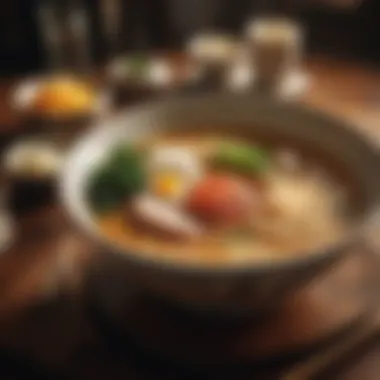
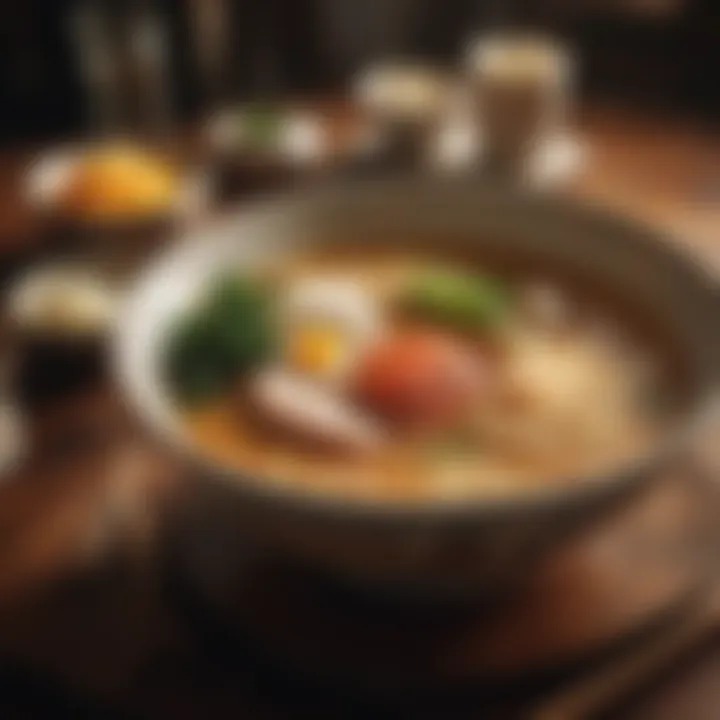
Intro
In the quest to illuminate the culinary prowess of Maru Ramen, one finds a rich tapestry woven with unique flavors and intricate techniques. The menu at Maru Ramen is not just a list of dishes; it is a celebration of ramen culture, reflecting thoughtful preparation and a homage to traditional practices. This examination aims to peel back the layers of complexity in Maru Ramen's offerings, revealing the distinctive ingredients, methodological approaches to cooking, and diverse cultural influences that combine to craft a memorable dining experience.
Food, at its core, serves as a universal language, and Maru Ramen speaks fluently. Diners—be they die-hard ramen aficionados or those merely curious—are welcomed into a vibrant world where every bowl tells a story. Each element, from the earthy broth to the meticulously selected toppings, is a nod to the tradition of Japanese noodle-making while embracing contemporary culinary trends. As we explore this menu, we will unveil the significance of Maru Ramen in shaping current perceptions of ramen, and speak to its commitment to satisfying a diverse clientele.
The integrity of Maru Ramen’s culinary landscape lies in its ability to harmonize authentic Japanese flavors with innovative twists—a reminder that culinary exploration is not merely about the plate but also about the passion and expertise behind it. In the sections that follow, we will dive deep into the various components that create this exceptional dining experience.
Foreword to Maru Ramen's Philosophy
Maru Ramen stands out in the booming ramen scene, but it's not merely about serving bowls of noodle soup; it’s about crafting an experience deeply embedded in cultural significance and authenticity. By looking into the philosophy that guides Maru Ramen, we can appreciate the layers of meaning behind each dish they serve.
Ramen is more than a meal in Japan. It has evolved into a beloved comfort food that connects individuals across generations. In a global context, it has transcended its humble beginnings and now symbolizes a unique blend of tradition and innovation, reflecting the ever-changing culinary landscape. Maru Ramen sources its inspiration from this rich history, weaving it into its menu, where each bowl tells a story of dedication, culture, and taste.
Cultural Significance of Ramen
The narrative surrounding ramen is vast, presenting a fascinating tapestry of tradition and modernity. This dish, thought to have been inspired by Chinese noodles, has since transformed and integrated itself into Japanese culture.
From Street Food to High-Cuisine
Ramen's journey from the bustling streets to upscale spots reveals its versatility. Originally enjoyed as a budget-friendly meal for many, it has now garnered a reputation and recognition that allows it to hold its own with other gourmet foods. Chefs globally are now giving their own takes, yet Maru Ramen stays grounded by respecting the original essence. This connects with diners who seek a genuine culinary experience.
Food as a Cultural Connector
By sharing ramen, individuals invite connection and community. Cooking and sharing a bowl at home can evoke shared memories, further underscoring food’s role as a cultural binder. Maru Ramen embraces this philosophy in their dine-in experience, encouraging sharing and conversation around their communal tables. Each slurp of ramen can evoke nostalgia, regardless of where one comes from.
Maru Ramen's Commitment to Authenticity
Authenticity is a hallmark at Maru Ramen, where every detail is crafted with care. From sourcing local ingredients to hand-pulling their noodles, they have rooted their process in traditional techniques while adapting to modern tastes.
Fresh Ingredients
Maru Ramen prides itself on using fresh, high-quality ingredients that reflect their dedication to authenticity. Locally sourced vegetables and meats ensure that flavors are vibrant and true to tradition. Each ingredient is chosen not just for taste but also for its story — where it comes from and how it is prepared.
Traditional Techniques and Modern Twists
In their quest for authenticity, Maru Ramen employs methods that have been passed down through generations. While embracing traditional broths and noodle-making techniques, they also infuse modern culinary twists that cater to a wider audience. For instance, their interpretation of classic flavors respects the origins while inviting curiosity from those unfamiliar with them.
"The essence of Maru Ramen lies in its ability to balance tradition with modernity, creating an experience that resonates with both purists and newcomers."
In understanding Maru Ramen's philosophy, patrons not only taste the food but also engage with a deep-rooted cultural narrative. Here, ramen is not simply a dish; it's a connection — to the past, present, and the vibrant community surrounding it.
Signature Dishes: An Overview
In the realm of ramen, signature dishes hold a central position, showcasing the unique characteristics and flavors that define Maru Ramen's culinary identity. These signature offerings not only reflect the restaurant's commitment to authenticity but also serve as a vivid canvas illustrating the intricate balance of tradition and modern culinary exploration. Delving into these signature dishes reveals the heart and soul of the menu, highlighting why they stand out among other establishments and how they cater to varying palates.
Shoyu Ramen: The Traditional Choice
Ingredient Breakdown
The ingredient breakdown of Shoyu ramen is quite revealing, as it plays a pivotal role in crafting the dish's foundational flavor. The typical constituents include a soy sauce-based broth, wheat noodles, and an array of toppings such as sliced pork, green onions, and sometimes narutomaki. These ingredients harmonize beautifully to create a comforting bowl that's not heavy on the stomach but rich in flavor. The use of high-quality soy sauce is key; it brings a umami richness that elevates the entire experience. In this offering, the balance between the salty soy and the sweetness of the broth is particularly compelling, making it a staple choice for both newcomers and ramen aficionados alike.
Flavor Profiles
When one considers flavor profiles, Shoyu ramen stands out with its delicate yet assertive seasoning. The broth has a clear brown hue that hints at its soy content and depth, often complemented by a subtle smokiness, thanks to the preparation techniques. It's not overly salty but has enough depth to engage the palate without overwhelming it. Each slurp tells a story, one that combines the earthy notes of the dashi and the bright tang of soy sauce. This complexity creates a multi-layered taste experience that makes Shoyu ramen particularly memorable.
Recommended Pairings
For those looking to round out their meal, several recommended pairings enhance the Shoyu ramen experience. A light, crisp salad dressed in sesame or a side of gyoza complements the ramen well. Alternatively, a cup of chilled sake can accentuate the flavors, with its clean finish acting as a brilliant counter to the savory broth. While the ramen itself is satisfying, adding these elements can turn a simple meal into a culinary event, showcasing the layered nature of Japanese dining culture.
Miso Ramen: A Rich Exploration
Origins of Miso Flavor
Miso ramen draws heavily from the rich tapestry of flavors rooted in Japanese history. The origin of miso itself can be traced back centuries, being valued not just as a seasoning but also as a source of nutrition. In this case, the distinct fermented flavor of miso—ranging from sweet to salty—adds a unique dimension to ramen. This depth of flavor resonates with customers who are eager to explore a more rustic variant, making it a favorite among those who seek heartiness in their meal.
Texture and Elements
The texture of miso ramen is another aspect worth noting. The creamy, sometimes slightly oozing broth interacts in delightful ways with the noodles and toppings, creating a mouthfeel that’s both comforting and satisfying. Key components often include corn, butter, and green onions, each adding layers of texture and flavor that enhance the overall dish. While the other toppings vary, this combination results in a harmonious bite that leaves a lasting impression on anyone's palate.
Serving Recommendations
When it comes to serving recommendations, the approach can greatly affect the enjoyment of miso ramen. This dish is best enjoyed piping hot, allowing the flavors to meld beautifully. It's often suggested to consume it right away to appreciate the sizzling freshness of the miso and toppings. Pairing it with a light Japanese lager can also brighten the flavors while cutting through the richness of the broth, making it a fulfilling yet balanced experience.
Spicy Ramen Variants
Heat Levels and Ingredients
Exploring spicy ramen variants opens up a world of heat and intensity that appeals to adventurous eaters. The heat levels can vary dramatically, depending on the type of chili used—whether it’s a shichimi togarashi blend or fresh chili paste. Customers frequently enjoy experimenting with the different spicy components, adding their own twist to the established flavors in the bowl. Simply put, these variants allow diners to play Creator, balancing spice with their personal flavor preferences.
Balance with Other Flavors
Finding balance in spicy ramen is crucial. The heat doesn't stand alone; it plays off the other flavors present in the dish. For instance, the richness of sesame oil and the sharpness of green onions can help mellow the heat, creating a multi-faceted taste experience. This balance is part of what makes spicy ramen variants a favorite among diners, appealing to those who enjoy layers of flavor rather than a singular, overwhelming spice.
Customer Preferences
Understanding customer preferences in spicy ramen variants paints a clear picture of the diverse tastes among diners. Some guests gravitate toward the fiery features, while others prefer just a hint of spice. The popularity of certain ingredient combinations varies across demographics, and property managers often find that catering their offerings based on ongoing feedback can lead to more satisfying experiences. Ultimately, it's this personalization that enriches the dining experience and keeps customers coming back for more.
Broth Varieties: The Foundation of Ramen
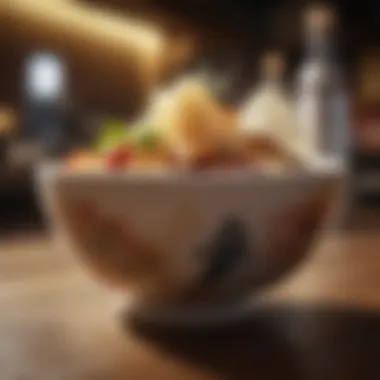

When one thinks of ramen, the broth often springs to mind. It’s the backbone of the dish, setting the stage for all other ingredients. The variety and depth of flavors in ramen broth can truly make or break a dining experience. At Maru Ramen, the significance lies not just in the taste but also in the thoughtful preparation and traditions behind each type. This section explores some of the core varieties of broth that define the essence of ramen.
Tonkotsu: The Creamy Standard
Preparation Techniques
Tonkotsu broth is revered for its rich, creamy texture, achieved by simmering pork bones over a long period—often a good 12 or even 18 hours. This slow cooking not only extracts flavors but also emulsifies fats, giving the broth its signature thickness. One standout aspect of the preparation is the use of high heat at the beginning to release the impurities, creating a cleaner flavor when the cooking time extends.
- Benefits: The depth of flavor brought out in tonkotsu is often considered unparalleled among ramen types.
- Drawback: The time-consuming nature of preparation may mean that not every establishment can replicate this layered taste.
Visual Characteristics
Tonkotsu broth possesses a cloudy, opaque appearance, which is a direct result of the emulsification process. This visual characteristic suggests a hearty and filling bowl, enticing diners to dive in. The broth typically holds a certain creaminess, with whites and yellows swirled throughout, making it visually appealing.
- Appealing Feature: The unique look helps distinguish tonkotsu from clearer broth varieties, drawing the curiosity of the menu explorer.
- Consideration: Its density may overshadow subtler flavors, requiring careful consideration of toppings that complement its richness.
Health Considerations
While tonkotsu offers an indulgent experience, health-conscious diners may raise eyebrows. The broth is high in fat and calories, which could deter some. It’s essential to balance enjoyment with mindful consumption. However, a small bowl can provide satisfaction without overwhelming caloric intake.
- Positive Aspect: It’s high in collagen, which can be beneficial for skin and joint health.
- Negative Note: Those with dietary restrictions or a desire to limit fat intake might find tonkotsu less suitable for their needs.
Vegetarian and Vegan Options
Utilizing Plant-Based Broths
For those not inclined towards meat-based broths, Maru Ramen embraces plant-based options. Here, the focus shifts to infusing umami from ingredients like shiitake mushrooms, kombu, and various vegetables. The resulting broth provides a lighter, yet flavor-packed alternative to traditional formats.
- Benefit: This allows a broader range of diners to enjoy the ramen experience, regardless of dietary preference.
- Potential Limitation: While rich in flavor, some might find the lack of the hearty texture present in tonkotsu less satisfying.
Popular Ingredients
A well-crafted plant-based broth often features star ingredients. Mushrooms are typically the crown jewel; their deep, earthy flavors create a base that many believe rivals the depth of meat-based broths. Alongside, ingredients like miso and various herbs bring layers that deliver complexity to the bowl.
- Highlight: Varieties such as king oyster mushrooms and fresh herbs elevate the flavor profile immensely.
- Drawback: Not all diners may appreciate the flavor of certain vegetables, requiring careful pairing on the chef’s part.
Satisfying Meat Alternatives
Meat alternatives in vegetarian ramen don't just serve as substitutes; they aim to satisfy the craving for a hearty bowl. Ingredients like tempeh or seitan can provide a chewy, protein-rich counterpart that many meat-eaters might find appealing.
- Key Point: Maru Ramen’s ingenious approach often leads to exciting new textures that surprise guests.
- Limitation: Some diners may wish they were savouring traditional meat instead, causing debate on the merits of absence versus substitution.
Noodle Selection: The Craft Behind the Texture
When it comes to ramen, the selection of noodles is not just a footnote in the culinary world; it’s the backbone that supports the entire dish. The right noodles can completely alter the perception of flavor and texture, making this aspect crucial to the Maru Ramen experience. A chewy, perfectly cooked noodle gliding through rich broth can elevate the simplest ingredients into something remarkable. Let's explore the types of noodles utilized at Maru Ramen and how their preparation methods contribute to the overall delight of the menu.
Types of Noodles Used
Wheat Noodles vs. Egg Noodles
Wheat noodles are often the classic choice when it comes to ramen. They bring a chewy mouthfeel that pairs beautifully with most broth types. These noodles absorb the flavors, creating a harmony that speaks to the essence of ramen itself. On the flip side, egg noodles offer a richer flavor profile, thanks to the yolks used in their creation. This makes them particularly popular in heavier, creamier styles of ramen.
One might find that the adaptability of wheat noodles enables them to cater to a wider spectrum of taste preferences, especially for those who might prefer a subtler base to their ramen experience. When you take a bite of these noodles, the subtle bounce is a hallmark of quality—crucial for a satisfying bowl of ramen.
"The right noodle can transform a bowl from ordinary to extraordinary, shaping the entire dining experience."
Impact on Overall Dish
The noodle's characteristics influence not just texture, but also the overall enjoyment of the meal. For instance, a thicker noodle can add heartiness to the dish, making it more filling and rich, whereas thinner noodles offer a lighter, more delicate mouthfeel. This interplay is vital in crafting the ideal bowl that appeals to a range of customers, from those seeking a light meal to those indulging in a deeply satisfying experience after a long day.
Whether it’s the width, thickness, or the particular texture, noodle choice directly influences the dish's balance. All of this contributes to how Maru Ramen curates their menu, focusing on ensuring that the overall effect of each dish remains captivating.
Customizations Available
At Maru Ramen, diners can expect flexibility with their noodle options. Not only can you select between wheat and egg noodles, but there's also the chance to tailor the noodle texture according to personal preference—some prefer softer noodles, while others enjoy a firmer bite. This adaptability caters to an array of clientele, enhancing the customer experience and inviting repeat visits.
These choices allow for a personalized touch, ensuring that every bowl feels uniquely suited to its diner. Such customizations encourage exploration within the diverse menu, offering a layer of engagement that keeps patrons coming back for more.
Cooking Techniques
Perfecting Texture
Achieving the ideal noodle texture is no small feat; it requires a practiced hand and an understanding of precise cooking methods. The process begins with the careful monitoring of the cooking time. Ramen noodles typically require a quick boil, often no more than a few minutes to achieve that perfect al dente texture. This is crucial because overcooking can lead to mushy noodles that don't hold up well in broth.
Maintaining firmness offers a delightful bite that harmonizes with the richness of the soup. The contrast of the chewy noodles with the fragrant broth keeps the dish lively, and it invites diners to savor every sip, enhancing their overall experience at Maru Ramen.
Timing for Al Dente
Timing is everything in noodle preparation. Knowing the exact moment to pull the noodles from boiling water can be the difference between a memorable meal and a bowl that leaves you wanting. With various factors influencing cooking times—thickness of noodles, the intensity of the boiling, even the altitude at which the ramen is cooked—each bowl requires a discerning eye.
The celebration of al dente noodles in ramen is a nod to authenticity, echoing traditional practices often seen in Japanese cooking. This technique ensures that the noodles maintain a satisfying viscosity, soaking up broth while still resisting entirely.
Pairing with Broth

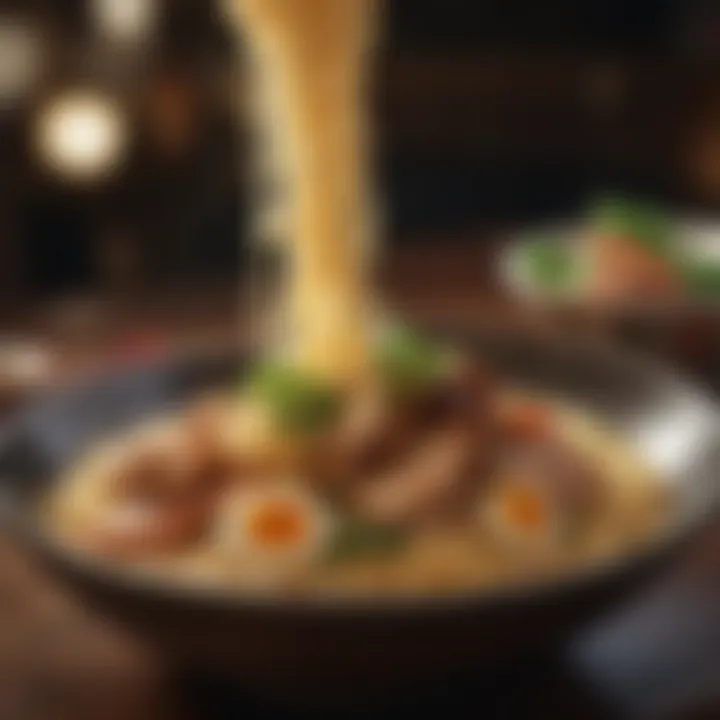
Lastly, pairing noodles with the suitable broth is another art form that Maru Ramen excels in. Different noodles harbor specific characteristics, with some complementing heavy, tonkotsu broth better while others are more suited for lighter shoyu or miso bases. The intention is to create a balanced dish where neither the noodles nor the broth overtakes the other's flavor.
As such, careful pairing not only highlights each component's strengths but also invites a full-bodied experience that engages the senses. This thoughtful consideration transforms a simple bowl of ramen into a multifaceted culinary delight.
In sum, noodle selection and preparation are paramount to the ramen experience at Maru Ramen. Each aspect is handled with precision, contributing to a well-rounded and thoroughly enjoyable journey from the bowl to the palate.
Additional Menu Offerings
When it comes to a ramen establishment, the focus often gravitates towards the ramen dishes themselves. However, it’s crucial to recognize that the additional menu offerings at Maru Ramen play a significant role in creating a well-rounded dining experience. These options not only provide a variety of flavors but also serve as complementary dishes that elevate the overall enjoyment of the meal, catering to different palates and enhancing the culinary journey.
Incorporating appetizers, rice dishes, and seasonal specials, these offerings reflect the diverse culinary culture of Japan. They allow diners to explore different textures, tastes, and temperatures, meaning the experience extends well beyond a single bowl of ramen.
Appetizers That Complement Ramen
Edamame and Its Variants
Edamame, young soybeans served in their pods, offer a simple yet satisfying start to the meal. What makes them special is not just their flavor but also their nutritional profile. Packed with protein, fiber, and essential nutrients, edamame is a popular choice for those seeking a healthy option. Their versatility shines through when they're prepared with various seasonings, such as sea salt or spicy chili dust.
One unique feature of edamame variants is how they can cater to different dietary preferences. The basic salted version is appealing, but infused flavors such as garlic or truffle oil determine how these delightful bites can be tailored to individual tastes.
While edamame is a nutritious choice, some may find them slightly bland without seasoning, so it’s worthwhile to sample several of the prepared options.
Gyoza: A Classic Side
Gyoza, those delicious dumplings, are a staple in Japanese cuisine. At Maru Ramen, these crispy-bottomed morsels filled with seasoned pork or vegetables hold significant character. Not only do they provide a textural contrast to the soft ramen noodles, but they also pack a punch when it comes to flavor.
The unique feature of gyoza lies in the careful preparation of their fillings, which are often made from fresh ingredients. The pan-frying technique gives them a distinctive golden crust. This preparation builds anticipation, as the gyoza arrives at the table sizzling hot, complementing the warmth of the ramen.
Despite their dove-tailing nature, gyoza can be a bit heavier, and some may prefer lighter options before indulging in the main ramen dish, possibly leading to meal fatigue.
Seasonal Specials
Embodying the philosophy of freshness, seasonal specials are a standout feature on Maru Ramen's menu. These dishes change periodically, reflecting what**s available and peak in seasonal flavors. They serve to surprise patrons with new tastes while keeping the dining experience dynamic and engaging.
One key characteristic of seasonal specials is their flexibility. During summer months, lighter, refreshing options may appear, while winter might bring heartier fare. This adaptability ensures that diners can experience the best of what each season has to offer.
The unique aspect of these specials is how they may incorporate local ingredients or innovative recipes that resonate with current culinary trends, making the dining experience more unique. On the downside, and due to their limited availability, guests may feel urgency to try items before they potentially disappear from the menu.
Rice Dishes and Their Pairing
Fried Rice Options
Fried rice at Maru Ramen serves as a delightful addition that can resonate with anybody looking for a complement to their ramen or simply wanting a flavorful dish to enjoy on its own. Prepared with fresh vegetables, protein options like chicken, pork, or tofu, fried rice presents a well-rounded option.
One key aspect of fried rice is its customizability. Diners have the ability to select various ingredients, enhancing the ability to tailor the dish to fit personal preferences. A significant advantage of the fried rice selections is how they can balance out the meal, ensuring satisfaction without feeling too heavy. Still, the richness of fried rice might be a tad overwhelming if enjoyed alongside a decadent bowl of ramen.
Signature Donburi Styles
Donburi, or rice bowls, present a delightful way to experience different flavors layered atop a bed of steaming rice. The signature donburi styles at Maru Ramen keep in line with the establishment’s philosophy of authenticity while offering a delightful touch. The various toppings, from grilled meats to sautéed vegetables, create a visually appealing dish as well as a hearty option for diners.
One key characteristic of these rice dishes is their diversity. Ranging from classic chicken katsu donburi to more adventurous flavor combinations, the options expand the choice for patrons. However, diners should be mindful of sizing; indulging in both donburi and ramen could lead some to a heavy-handed dining experience.
Balancing Flavors
In Japanese cuisine, the concept of balancing flavors is prehistoric. Maru Ramen exemplifies this philosophy through its menu offerings. By ensuring that the rice or appetizers chosen serve to balance the richness of the ramen broth, diners can experience a harmonious meal.
Important here is the juxtaposition of flavors such as sweet versus savory or spicy against mild. A well-prepared meal at Maru Ramen will include complementary flavors, creating a full and rich sensory experience. The disadvantage, however, can arise when diners overthink their pairings, leading to confusion or disconnection between dishes.'
"The balance of flavors is key to a satisfying meal, reflecting the very best of ramen's culinary landscape."
Desserts to Conclude the Experience
Desserts serve as a capstone to the culinary journey at Maru Ramen, offering diners a delightful transition from savory to sweet. This final touch can transform a good meal into a truly memorable one. It reflects not only the restaurant’s commitment to excellence but also pays homage to the sweet side of Japanese cuisine. A well-curated dessert menu reinforces the idea that dining is an experience to be savored, right down to the last bite. By including traditional elements alongside innovative creations, Maru Ramen aims to cater to diverse palates and ensure guests leave with satisfied taste buds and a sense of contentment.
Traditional Japanese Sweets
Mochi Varieties
Mochi is a cherished aspect of Japanese dessert culture that stands out for its unique texture and versatility. Made from glutinous rice, mochi can be enjoyed in various forms, whether plain or filled with sweet ingredients like red bean paste. The chewy texture of mochi offers a distinctive mouthfeel that contrast with the smoothness of soups or broths, making it an appealing end to a hearty ramen meal.
A key characteristic of mochi varieties is their ability to be molded into different shapes and served with a variety of flavors. This flexibility in presentation means that diners can experience an array of tastes—such as the subtle sweetness of mochi filled with matcha or a more indulgent chocolate center. Not only is this dessert easy to personalize, but it also gives a sense of connection to traditional Japanese dining practices, where sweets often feature seasonal ingredients.
While mochi is undoubtedly a popular choice, there are a couple considerations to keep in mind. Those with gluten sensitivities may need to avoid it, as traditional mochi is made from glutinous rice. Additionally, the chewy texture may not be to everyone’s liking, which emphasizes the need for diverse options on the dessert menu.
Seasonal Fruits
Seasonal fruits hold their own charm, often regarded as a refreshing end to a meal. Highlights of the Japanese dessert landscape, fruits such as yuzu, strawberries, or persimmons offer bright flavors that cleanse the palate after the richness of ramen broth. Their key characteristic lies in their natural sweetness and vibrant colors, making them visually appealing to diners.
Incorporating seasonal fruits showcases Maru Ramen's commitment to freshness and quality. This not only ensures that guests enjoy the best flavors at any given time but also aligns with sustainable dining practices, as procuring ingredients in season reduces the carbon footprint. The unique feature of seasonal fruits is that they can be served in various forms – from a plain fruit platter to a more complex dessert like fruit sundaes or sorbets.
However, a downside is that the availability of certain fruits can be limited, which might restrict menu options depending on the time of year. Nevertheless, utilizing seasonal fruits puts a spotlight on Japanese agricultural produce and can excite diners with what the season has to offer.
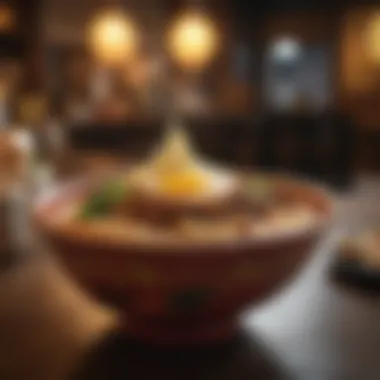
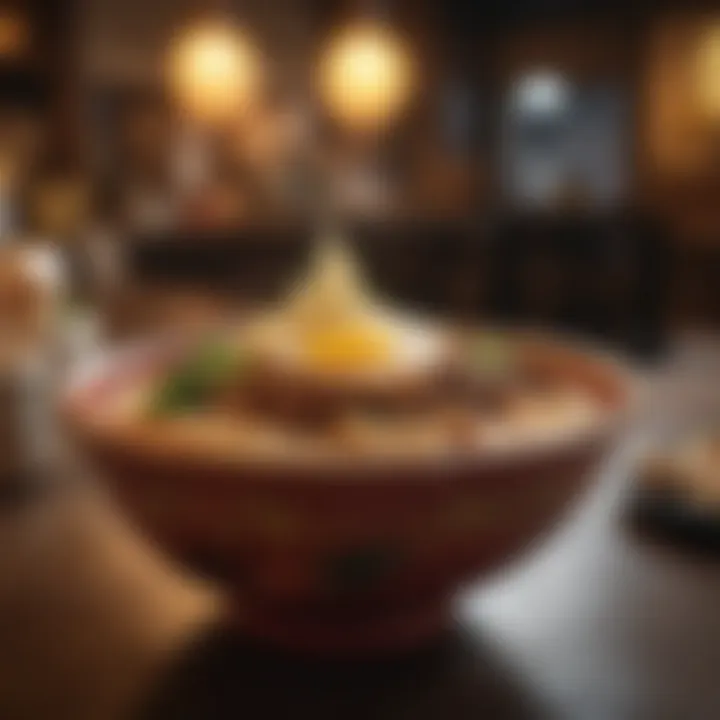
Matcha Delights
Matcha, a finely ground powder made from specially grown green tea leaves, has emerged as a beacon of Japanese desserts. This ingredient is celebrated for its earthy flavor and health benefits, serving as a delicate balance to the more robust flavors found in savory dishes. Maru Ramen’s focus on matcha delights symbolizes a trend toward healthier eating without sacrificing taste.
The standout characteristic of matcha delights is their versatility, appearing in various forms from matcha ice cream to creamy matcha cheesecake. Each offering has its own unique flavor profile, often combining the rich umami notes of matcha with sauces or creams that elevate the experience. Matcha desserts not only provide a colorful treat but also appeal to health-conscious diners looking for antioxidants within their sweet indulgence.
However, not everyone may appreciate the distinct flavor of matcha, which can be an acquired taste. This highlights the importance of offering a range of options to cater to all preferences.
Innovative Takes on Desserts
Fusion Flavors
Maru Ramen embraces culinary creativity through the fusion flavors birthed from traditional Japanese techniques. These innovative desserts combine familiar tastes with new twists, offering a diverse range of options. For instance, the pairing of matcha with Western ingredients, such as chocolate torte, or the integration of citrus notes with French pastries.
The beauty of fusion flavors lies in their ability to surprise and delight diners, elevating even the simplest dessert to remarkable heights. They have the potential to cater to an audience eager for a blend of cultures and an expanded palate. However, one must tread carefully, as not every fusion attempt resonates; balance is key. There’s a line between creativity and a muddled dish, making careful, thoughtful construction necessary.
Presentation Techniques
Presentation plays a crucial role in the dessert experience at Maru Ramen. A beautifully arranged dessert can captivate diners before they even take their first bite. Techniques such as layering elements in a clear dish or complementing colors can enhance the appeal of any dessert. This focus on aesthetics not only makes each dish more appetizing but also encourages diners to share their experiences on social media—great for building an online presence and attracting more guests.
However, a strong focus on presentation may occasionally overshadow taste, if not executed correctly. It is important that while the visual aspect shines, it does not detract from the flavor profile's quality. The challenge lies in achieving a balance, ensuring that the visual allure complements rather than competes with the taste.
Guest Favorites
Guest favorites provide an invaluable insight into the dining experience at Maru Ramen. These desserts often end up being crowd-pleasers, showcasing what resonates with visitors. By incorporating popular dishes into regular rotation, the restaurant can capitalize on both customer satisfaction and feedback, ensuring that guests leave happy.
Such items typically bear a signature twist, whether that’s a specific flavor, style, or presentation that diners rave about. One unique feature is that they can also transcend seasonal menus, maintaining their popularity throughout the year.
That said, leaning too heavily on guest favorites can risk staleness in the menu. Variety remains essential in keeping the dining experience dynamic and engaging. Therefore, while keeping customer favorites, introducing new elements ensures that diners always have something exciting to look forward to.
Beverage Pairings: Enhancing the Dining Experience
Beverage pairings can significantly elevate a meal, and at Maru Ramen, the options are diverse. It's not simply about quenching thirst; it’s about creating a harmony between flavors that enhances the overall dining experience. With the right drink, one can accentuate the nuances of a spicy bowl of ramen or the delicate sweetness of desserts. This section explores the roles that various beverages play in complementing the intricate flavors found on Maru's menu.
Sake and Its Varieties
Choosing Sake for Your Meal
Choosing the right sake is essential for a complete experience. It’s like finding the perfect dance partner; the flavors need to synchronize. Each sake type has its own profile that can either enhance or overshadow the dish at hand. For instance, a Junmai sake pairs nicely with richer ramens like Tonkotsu, bringing out the creaminess without clashing. On the other hand, a Ginjo sake with its fruity notes might best suit a lighter Shoyu ramen. Ignoring this aspect could mean losing an opportunity to enrich your meal, as each sip of sake should resonate with the last slurp of ramen.
Tasting Notes
Tasting notes are vital in appreciating sake. Each type presents a mix of aromas and flavors that can range from fruity to earthy. For example, you might detect hints of melon and apple in a Ginjo variety while a Junmai can boast a robust umami profile. Understanding these notes not only helps in enhancing your meal but also adds to your overall culinary knowledge. However, be aware; some may find it hard to distinguish flavors, which can detract from the enjoyment.
Serving Temperature
The temperature at which sake is served can dramatically influence its taste and aroma. Chilled sake, typically Ginjo, tends to showcase its fruity, fresh qualities, while warming enhances the rich, savory notes of Junmai varieties. Ideally, serving temperatures can go as low as 50°F for chilled sake or as high as 120°F for warm sake. Understanding these subtleties is crucial, as serving a particular type too cold or warm could flatten its flavor profile.
Non-Alcoholic Options
Japanese Teas
Japanese teas are the unsung heroes of beverage pairings. They offer a lightness that can cleanse the palate especially after a hearty bowl of ramen. With a variety from matcha to Sencha, each tea brings its own depth and character. For example, a delicate Sencha can balance the robust flavors of miso ramen with its subtle grassy notes. The downside? Some may prefer stronger flavors that teas might not provide.
Flavored Soft Drinks
Flavored soft drinks can be an unexpected delight alongside ramen. Here, you have choices ranging from yuzu-flavored sodas to classic Ramune. These beverages can bring a refreshing burst of flavor, contrasting nicely with savory dishes. However, one needs to be cautious; the wrong pairing could become overwhelming or clash with the umami present in ramen. Keeping an eye on the sweetness level is key.
Craft Sodas
Craft sodas provide an artisanal touch to the dining experience. Typically made with less sugar and unique flavor combinations, they can stand out as an interesting pairing. Think of a ginger-infused craft soda alongside spicy ramen; the spiciness is tempered while flavor remains vibrant. However, not everyone might appreciate the complex flavors, especially if they tend to favor conventional carbonated drinks.
The right beverage can remarkably uplift your culinary journey at Maru Ramen, making every bite even more memorable.
Ending: The Culinary Journey at Maru Ramen
As we wrap up our exploration of Maru Ramen's intricate menu, it's essential to recognize the significance of this culinary journey. Each dish, from the rich shoyu ramen to the delicate desserts, tells a story woven from tradition and innovation. This diversity not only reflects the restaurant's commitment to authentic flavors but also showcases how ramen has evolved in contemporary dining.
A pivotal aspect of this article is understanding how Maru Ramen brings forth the intricacies of Japanese cuisine, stepping beyond mere meal provision. The careful selection of ingredients and meticulous preparation techniques are the keystones of an exceptional dining experience. For example, the vibrant spices in their miso ramen harmoniously balance traditional Japanese tastes with personal twists that cater to local palates.
Engaging with the menu at Maru Ramen goes beyond mere consumption; it invites diners to actively reflect on their choices. Customers can delight in the interplay of flavors and textures, making every bite an opportunity for introspection. Whether a first-time diner or a long-time aficionado, the thoughtful design of the menu fosters connections through shared experiences.
"Food is not just nourishment; it is a bridge connecting people and cultures."
Reflecting on the Menu Experience
The menu experience at Maru Ramen transcends simple taste. It's carefully constructed, ensuring diners can appreciate the journey through each course. When one assesses the offerings, the importance of variety becomes apparent. With choices ranging from vegetarian options to heartier tonkotsu, there’s something for everyone.
Moreover, what stands out is how the dishes are each presented. Not only do they taste appealing, but they are also a feast for the eyes. This artistic presentation elevates the overall experience, allowing customers to savor not just the flavors, but the visual allure too.
The ambiance complements the culinary offerings. Subtle design choices in the restaurant reflect elements of Japanese culture, adding an extra layer of immersion into the world of ramen. Dining at Maru Ramen becomes as much about the experience as the meal itself, with memories of flavorful moments lingering long after the last bowl is consumed.
Future Directions for Menu Development
Looking ahead, Maru Ramen appears poised to embrace continuous evolution. The culinary landscape is ever-changing, and adapting to new trends while maintaining tradition will be crucial. One area to explore is seasonal menus, utilizing fresh, local produce to craft limited-time offerings that excite returning customers.
Additionally, expanding on the fusion aspect of the menu could attract a broader audience. Incorporating influences from global cuisines can yield innovative dishes that still honor the ramen tradition. For instance, experimenting with flavors from Mexican or Italian cuisine could provide an intriguing twist on familiar favorites.
Finally, interactive dining experiences could be another avenue for growth. Hosting events like ramen-making workshops not only engages the community but also deepens their appreciation for the craft involved in each bowl. Such initiatives would not only enhance the customer experience but also fortify Maru Ramen's standing as a cornerstone of culinary discovery.















